How to Apply Thevenin’s Theorem for Solving Circuits with Dependent Sources
Besides its use to simplify and calculate currents in electrical circuits, Thevenin’s Theorem is also a great tool that we can use to derive transfer functions. This article will illustrate how to derive the small signal transfer function of the Common-Collector Amplifier with bipolar junction transistors (BJTs).
The circuit is shown in Figure 1. It is also called a repeater, so we expect that the calculated transfer function to be close to unity gain.
Figure 1
In this figure I noted with VI the DC input bias level at the transistor input and with vi, the AC input signal, which rides on the DC level. We need to derive the small signal transfer function vo/vi.
Let’s first replace the transistor with its small signal equivalent circuit (see Figure 2). This model is valid for small signals, where the transistor transfer function can be considered linear. For large signals, the model is different involving an exponential relation between its input and output signals.
Figure 2
Thevenin’s Theorem states that networks with voltage and current sources, as well as resistors are electrically equivalent to one single voltage source and one single resistor in series with the source. In order to apply Thevenin’s Theorem, let’s disconnect RE, as in Figure 3. We will calculate the Thevenin equivalent source of this simplified circuit.
Figure 3
In Figure 3 I noted the open circuit voltage with voc. The derivation of this voltage is really simple. From Rsource, r∏ and voc loop, the voc equation is
| (1) |
We have one node equation in this circuit and the algebraic sum of the node currents has to be zero.
| (2) |
This equation can only be valid if ib is zero. If ib is zero, then
| (3) |
Next, we need the Thevenin resistance, rth. This is the resistance seen inside the source, as looking from its output. In a previous article, How to Apply Thevenin’s Theorem – Part 1, I calculated the Thevenin resistance by short-circuiting the voltage sources and disconnecting the current sources. That method is valid for circuits with independent sources. This circuit has a dependent source, β ib, which cannot be disconnected. We need another way to calculate rth.
For circuits with dependent sources, rth is calculated by dividing the open circuit voltage, voc, by the short circuit current, isc, at the circuit output. As such, let’s short-circuit the circuit output, as in Figure 4, and calculate isc.
Figure 4
| (4) |
and the Thevenin resistance is
 |
(5) |
With voc and rth known, we can calculate the transfer function of the circuit in Figure 1. All that’s left is to connect the emitter resistor, RE at the Thevenin source output as in Figure 5.
Figure 5
RE and rth make a voltage divider for voc, so vo is
| (6) |
Since voc equals vin, the small signal transfer function of the common collector amplifier is
| (7) |
Q. E. D.
>>> <<<
The transfer function shows that the gain of the common-collector amplifier is almost one. Indeed, RE (β+1) is large compared to Rsource and r∏. Mathematically speaking, when RE (β+1) tends to infinity, the vo/vi limit is 1, confirming the universal knowledge that the common collector amplifier has a unity gain.



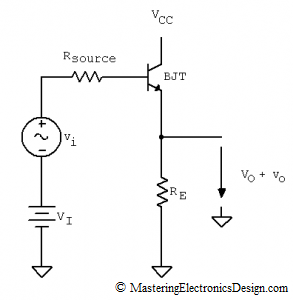
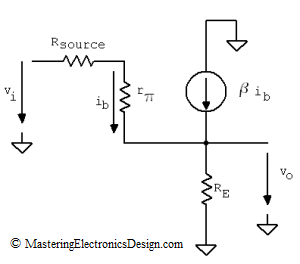
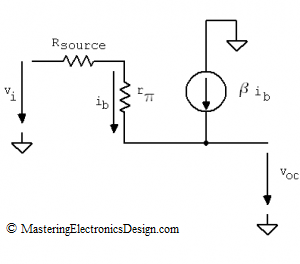
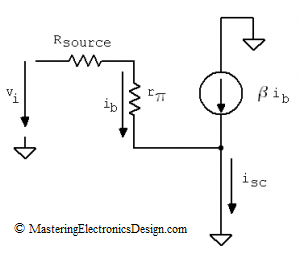
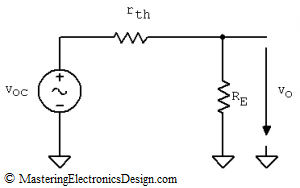


How would this analysis produce familiar results when there is some collector resistance and the output is taken at the collector in the inverting amplifier arrangement? Thanks.
Sounds like an analysis for a common emitter amplifier. I will write an article about this soon.
interesting notes. I found it is better to measure the output impedance. Thevenin. Large signal models are off. For very low current (uA) the models are off.
The impedance is changing with the signal flow up and down. High power transistors 50W-200W out change impedance with the signal. The interesting thing is what number to use. For small chips this might be good enough.